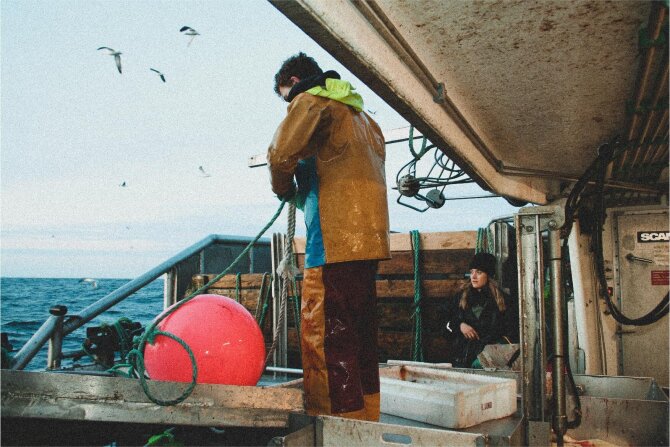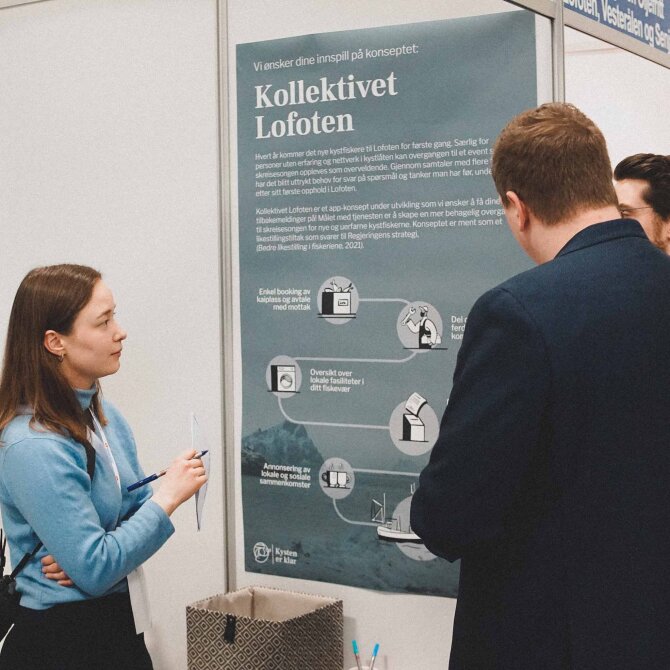Diversity and equality in coastal fishing
One of Norway's major equality challenges is the gender-segregated labour market. Only three percent of Norwegian professional fishers are women. 'The coast is clear' is a Master’s thesis in service design, with a strategic, feminist design approach. The project aims to show how design methodology can contribute to facilitating a more equal, diverse culture for coastal fishers in Norway.
Master’s thesis in design: Eila Regine Evensen Rishovd and Elizabeth Bjelke Stein, Oslo School of Architecture and Design (AHO)
Lead users:
Coastal fishers in Norway. The design emphasizes targeted universalism, with a focus on meeting the needs of female fishers and young, inexperienced coastal fishers.
Methods:
Theoretical analysis, in-depth interviews, workshop facilitation, field observations and contextual interviews, “Field trip diary” (tool for reflection), data analysis, giga mapping, ideation, user testing, visualisation.
Awards:
Innovation Award for Inclusive Design 2023 by Design and Architecture Norway, category winner Young Talents. Prize for Complexity and Holistic Approach, AHO Awards 2022 .
4
weeks fieldwork in Lofoten.
Challenge: Exclusionary attitudes in the fishing industry
Students Eila Regine Evensen Rishovd and Elizabeth Bjelke Stein at the Oslo School of Architecture and Design (AHO) wanted to work with sustainability, diversity and equality in their master's thesis in design. They particularly wanted to explore these issues within practical occupations and decided upon the fishing industry.
Norway is the second most equal country in the world (SSB, 2022), with fish as the second largest export (SSB, 2022). Nevertheless, the proportion of fishers that are women is only 3 % (Ministry of Trade, Industry and Fisheries, 2021).
In recent years, female fishers have shared their experiences relating to discrimination and a lack of provision for diversity in the fishing industry. Concurrently, the industry is reporting a particular need for different types of expertise and perspectives in order to further develop it´s procedures and make a shift towards more sustainable procedures. This became the challenges the students aimed to examine.
Rishovd and Stein set out to answer two major questions in their master's thesis: namely how to increase diversity across gender, age and background in the fishing industry and how to change negative attitudes, and thereby the culture, which leads to underrepresented groups leaving.
The students tackled the challenges through the use of service design with a strategic, feminist approach. The result of the work is "Kollektivet" (The Collective), which functions as a meeting place and practical resource centre for coastal fishers.

Approach: Identified a vulnerable group
The students worked towards acquiring an all-round understanding of the challenges relating to equality in the fishing industry. They wanted to gain a deeper understanding of what the challenges are, what can be achieved through change and what are the underlying attitudes.
Through research, consisting of reports and news articles on the subject, as well as a number of in-depth interviews with fishers, industry stakeholders and experts on gender equality, they formed an increased understanding of the challenge within the industry, and a specific focus for the project.
Coastal fishers are vulnerable to exclusion in a number of ways. Through a series of interviews, the students discovered that each fishing village has its own culture. Less experienced fishers are often largely unaware of these cultures and nor do they know what facilities each village has to offer. The analysis of collected data showed that fishers with an underrepresented identity, such as women or persons with a different ethnic background – as well as inexperienced fishers – felt particularly vulnerable and exposed when they came to a new, unfamiliar fishing village.
The solution the students proposed through their master's thesis helped coastal fishers feel included in the local communities linked to the various fishing villages, and to contribute with concrete measures perceived as relevant.
Fieldwork and workshops
An important part of the design process was to gather real insights from a diversity of fishers, industry stakeholders and other users, and listen to their perspectives.
From the outset, the students recognized the importance of listening to different perspectives to developa nuanced understanding of the topic. When their insight revealed that fishers with underrepresented identities were most frequently subjected to discrimination and exclusion, they decided to focus on and emphasizethe perspectives and needs of this group.
The students also acknowledged that their own attitudes, prejudices and identities could affect the insight they came to gather and the observations they made. They therefore developed a tool for ongoing self-reflection when collecting data.
To ensure an inclusive design process they recognized the importance of experiencing the culture, as well as the physical and practical challenges of the fishing profession, together with the focus groups in their natural environment. Rishovd and Stein thus chose to travel to where many people are involved in coastal fishing, more precisely Lofoten.
The students spent four informative weeks among fishers on land and at sea. It became clear that most fishers came from families with a long history in the industry, where knowledge and attitudes were passed down through generations. This made it particularly challenging for those without family ties in the industry to gain a sense of belonging.
It also became clear that many new fishers across gender and ethnicity struggled to build social networks they could rely on and had limited resources when facing practical challenges in their work.
The barriers were evident: lack of practical knowledge, inherited attitudes and few opportunities to build networks fromfrom one fishing village to another.. In response,the master's students began to draft a tool that challenge traditional assumptions about what defines a typical fisher. Their goal was to empower the underrepresented groups by giving them the resources and the network they need, as a measure to increase equality and diversity in the industry.
To adress this issue, the concept proposal 'The Collective' was developed. The concept is a digital platform, designed as an app,, which aims to facilitate for visiting fishers and underrepresented groups in the industry. The overarching strategic goal is to foster a cultural shift within Norwegian fishing communities.

Through extremely thorough user testing, exemplary use of design methodology and close contact with the industry, the students have designed services that will create a lasting cultural change in an environment many feel excluded from.
Result: Making use of services that already exist
With thorough insight work behind them, the students were able to outline how the ‘The Collective’ could contribute to more inclusion: It was to happen through the use of very practical resources. The data they had collected showed that the service needed to provide coastal fishers with both cultural and practical information for each individual fishing village. It also had to help connect fishers together socially, and to highlight competence, experience and career aspirations vis-à-vis the professional operators in the industry.
They quickly understood that a proposed solution could not simply address symptoms of structural challenges, such as reporting harassment. Instead, it needed to tackle the root causes. In the long term, the students aimed to effect a long-term change in industry attitudes by strengthening the position of the underrepresented coastal fishers ensuring they had better access to resources and career opportunities. Importantly, these resources and services would be available to everyone.
The students' design proposal, 'The Collective', is a digital platform that helps coastal fishers overcome the barriers they encounter when arriving in unfamiliar fishing villages. The platform connects fishers, operators and local communities. The primary goal is for fishers to feel a sense of belonging, obtain an overview of and support from their environment and to be given the opportunity to address and act on their own needs. The true value of the platform lies not in its features but in the outcomes it facilitates.
In Norwegian fishing villages, there are many resources, such as shore power, postal services, local welfare/fishers’ homes and berths. For fishers arriving in unfamiliar fishing villages, it can be difficult to make use of these resources as it requires a local network to locate them. ‘The Collective’ makes these facilities and services easily accessible, creating value for fishers in the form of experiencing control and predictability. It also benefits service providers by optimizing the use of their resources.
Fishers can use "The Collective" to access information about local resources and connect with the industry through a notice board and chat function. This allows them to stay informed about current issues in the industry or in the fishing village they are in and to connect with other fishers, organizations, or interested parties. Larger organizations, which often struggle to find candidates with the right skills for management positions, also benefit from this platform.
These organizations also have a need for greater diversity. Yet persons from minorities often face barriers when involving themselves. One key function of ‘The Collective', is to facilitate better dialogue and visibility between industry operators and fishers. For this reason, the platform allows fishers to showcase their expertise in their profiles, making it easier for them to participate meaningfully in industry processes and to seek help when needed. By highlighting their skills to others also makes it easier for fishers to approach each other when they need help.
By providing information and fostering connections, the students hope to improve fishers' job satisfaction and overall well-being. ‘The Collective’ not only supports non-traditional fishers but is also valuable for more traditional, older male fishers. This inclusivity is why all fishers can be united on the same platform.
Promoting inclusion through design
The master's thesis 'The coast is clear' reflects the value of designers entering unfamiliar contexts to work with underlying attitudes and those who are underrepresented.
The solution proposal ‘The Collective’ is designed to break down barriers. It illustrates how measures aimed at underrepresented groups can also be valuable and relevant to those outside these minorities.The proposal works on the basis of practical solutions that are desired by 'everyone' regardless of identity and background.
By working with design methodology in this way, Rishovd and Stein have challengeda culture rooted in tradition and prejudice. Their approach and proposed solution also hold potential for application in other industries facing similar challenges.
Benefits: Designing for the underrepresented
The solution presented by Rishovd and Stein has been very well received, including by the Norwegian Fishermen's Association. The Master students' choice to combat the problems using service design has opened many eyes in the industry to this method.
The students have also made fishing industry operators aware of the underlying problems which exist in the industry. And by designing services for the underrepresented, they have drawn up solutions that benefit all fishers. The students have succeeded with the concept by making use of services that already exist, then framing the services with a holistic and universal design perspective that is familiar and accessible to the vast majority. In this way, they promote the interests of multiple groups.